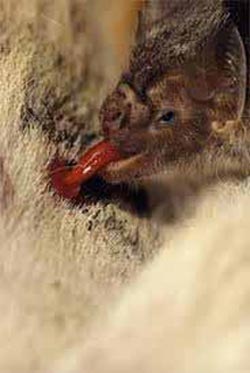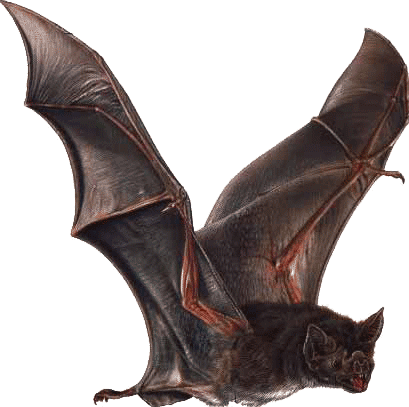|
|  The Vampire Bat
They adapt well to captivity and are often exhibited in zoos. These bats may be among the best studied in the world. Vampire bats are members of the New World Leaf-nosed bats. All three species of living vampire bats occur in South and Central America. Fossils of three other species reveal that several thousand years ago vampire bats were more widespread. With the exception of captive animals, vampire bats have never been found outside of the New World. The three species are medium- seized, with adult wingspans of 320 to 350 mm and weights of about 40 grams. While they are larger than most of the bats of the temperate zones of the world, vampire bats are much smaller than Gigantic Flying Foxes, which weigh in at 1,500g. Horror movie depictions of vampire bats often use Flying Foxes as models because larger bats are easier to photograph. This contributes to the public perception of vampire bats as large, terrifying animals. But animals that feed on blood, whether they are insects, leeches or bats, tend to be small because blood is a precious commodity and hard to obtain in large amounts.   It seems common to suppose that myths about vampires and stories about Dracula somehow involve vampire bats. The truth is that vampire bats got their names from myths about vampires. In many cultures, vampires are people who return from the dead to feed on the blood of living people. After the bats were discovered by European explorers, they were given the name vampire, denoting blood-feeding. The blood-feeding was well known to the inhabitants of South and Central America well before their discovery by Europeans. Even though living off of blood is a challenge, it is the occupation of many species of animals from differ- ent evolutionary backgrounds. In many ways blood is an ideal food. Within the bodies of animals with backbones, the vertebrates, blood is the central ingredient of the circulatory system. It flows in vessels, dispensing food and oxygen through the body and collecting wastes for removal. Blood consists of water-like plasma, chemicals, red blood cells and white blood cells. The blood cells represent the nutritious part of blood. Keeping blood in vessels, arteries, veins or capillaries en- sures that it flows more efficiently. The systems that protect blood illustrate its importance to animals. A variety of mechanisms such as clotting and con- striction of veins keep an animal from bleeding to death through a small wound. Blood is constantly manufactured in the body, so it is a renewable resource and a complete food. In mammals and birds, which are thought to be the usual prey of vampire bats, blood amounts to 6-10% of the animalís weight.  The bat leaves its roost just after dusk, setting out to find a meal. The relatively long and narrow wingsó providing a high aspect ration on high wing loadingómake it possible for the Common Vampire Bat to fly rap- idly and consume relatively little energy in doing so. Radio-tracking studies sug- gest that a foraging Common Vampire Bat returns to a general area where it has found prey before. Having reached its foraging area, the bat must find and select a victim. The fine details of its search and selection behavior remain unknown. However, the inferior coliculus, part of the batís brain that processes sound, is specialized for detecting the regular breathing sounds of a sleeping animal such as a cow. The bat lands on the ground near its intended victim and approaches on foot. Among bats, Common Vampires are the most agile on the ground, hopping about like ballet dancers. There is a heat (infrared) sensor on the nose-leaf of Common Vampire Bats, permitting them to locate an area where the blood flows close to the skin. If there is fur on the skin, the Common Vampire Bat uses its canine and cheek teeth like a barberís shears to clip away the hairs. The batís razor-sharp upper incisor teeth lack enamel, making it easier to keep them razor sharp, and are used to make a quick cut, leaving a wound approximately 5 mm deep and 5 mm in diameter without cutting arteries or veins. If you made a wound this size on your body, it would produce about one drop of blood or less than a gram.  The bat then begins to use its tongue in the wound as well as its saliva. The action of the tongue keeps blood flowing, while grooves on the underside of the tongue draw blood toward the batís mouth. Meanwhile, the saliva has at least three active ingredients that promote bleeding. One is an anticoagulant that counters the clotting defenses. A second keeps red blood cells from sticking to- gether and a third inhibits the constriction of veins near the wound. It may take the bat about 20 minutes to take its fill, it is then time to take off and return to its roost. Inside the batís stomach the lining rapidly absorbs the blood plasma. In turn, the circulatory system shunts the plasma to the kidneys. From there it passes to the bladder and out of the bat. Within two minutes of beginning to feed, a Common Vampire Bat begins to urinate. The urine is very diluteóno wonder, it is the plasma from the blood meal. The plasma is heavy but contains no nutritive value, so the bat benefits from leaving it behind. Shedding the plasma makes taking off from the ground easier. But the bat still has added almost 60% of its body weight in blood. To take off from the ground the bat must generate lots of lift. Common Vampire Bats have very long thumbs. As the bat prepares to take off it crouches close to the ground and then, by contracting its chest muscles, flings itself skyward. The thumbs provide extra leverage for takeoff. Usu- ally within two hours of setting out, the Common Vampire Bat returns to its roost and settles down to spend the rest of the night digesting its blood meal.  Each vampire bat, whatever the species, needs about two tablespoonful of blood every day. This represents about 60% of the batís body weight, or 20 g of blood. It appears that vampire bats are ďone stop shoppers,Ē feeding on one victim each night. Getting 20 g of blood from a wound that normally produces just one drop is a special- ized business. One stop shopping for vampire bats will only work with large prey, and the availability of large prey and the difficulty of obtaining large amounts of blood which probably explains why vampire bats are no bigger than 40g. Common Vam- pire Bats usually roost in hollows, so they may be found in caves, hollow trees and buildings. They live together in structured societies that provide a network of social support. Like other bats, Common Vampires are long-lived. Banding studies suggest that some survive almost 20 years in the wild, and reveals that individuals remain in their roosting groups for at least three years and probably for their entire lives. Colo- nies of Common Vampire Bats usually include one adult male with several females and their young. The bats may not all roost together at any one time, for they move between several roosts within the home range of the colony. Females that roost together often forage in the same general area, and several bats may line up, feeding in succession at a wound.  When a Common Vampire Bat returns to the roost they often meet face-to-face and groom one another. A bat that fails to feed uses this face- to-face contact to beg blood from a roost-mate. The successful bat may then regurgitate some blood to the unsuccessful one. The cost of the donor is relatively small, particularly since before the month is out it will need a donation itself. The benefit to the receiver is high, for it is sur- vival. Vampire bats are among the most fascinating of mammals, al- though we know relatively little about the details of their lives. Whether you consider their anatomical or physiological specializations or their amazing social structure, the vampires are among the most exciting of bats.
Click here to return to the main page for Caribbean Critters
|
 Itís that time of the year, when we hear of things ghouly, shivery and scary. For many, the month of October is synonymous with Halloween, and a
major symbol for this fun time is the bat. The Common Vampire Bat (Desmodus rotundus) is classified in the order Chiroptera, and within the family Phyllostomidae. Vampire bats feed only on
blood, a fact that sets the human imagination racing. There are two other vampire bat species, the white-winged
vampire bat and the hairy-legged vampire bat. The Common Vampire bat makes up about 99% of
the entire vampire bat population and is the most widespread of vampires.
Itís that time of the year, when we hear of things ghouly, shivery and scary. For many, the month of October is synonymous with Halloween, and a
major symbol for this fun time is the bat. The Common Vampire Bat (Desmodus rotundus) is classified in the order Chiroptera, and within the family Phyllostomidae. Vampire bats feed only on
blood, a fact that sets the human imagination racing. There are two other vampire bat species, the white-winged
vampire bat and the hairy-legged vampire bat. The Common Vampire bat makes up about 99% of
the entire vampire bat population and is the most widespread of vampires.
